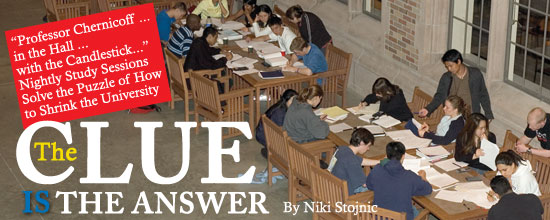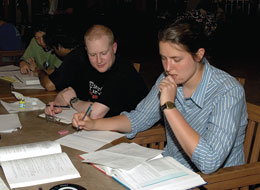

Word of mouth spread quickly. At the end of the school year, "45,000 visits took place averaging 300 to 500 students a night. Now we are well beyond that," he reports. As for the original six CLUE students, one continued to come for the rest of the term.
It's going to take some time, Chernicoff says, to conduct research on CLUE's effect on student performance, such as boosting grade point averages. But students have provided plenty of anecdotal evidence that CLUE is having an impact.
Jobs, extracurricular activities and noisy roommates can eat away at precious study time. "You absorb more here," says mathematics junior Paul Mulvaney, who comes to CLUE regularly. "The people here explain [the material] better, and it's a very good place to study."
Education graduate student Peter Cheng, one of the CLUE tutors for math and physics, says that he would have attended a program like this if there had been one at his undergraduate university. "It's accessible to students when they need to study."
 Professors, such as Deines, appreciate their CLUE time as well—particularly when there are illuminating moments that veer away from reviewing the day's class notes.
"I can recall a great conversation about the motif of the mandala, which is used in Hindu architecture and Buddhist culture and architecture," she says. "We all learned more about the mandala that night, thus more about South Asian cultures and the relation of this to architecture. I appreciate times in which it's clear to me that culture and architecture are clearly linked in the students' minds."
Professors, such as Deines, appreciate their CLUE time as well—particularly when there are illuminating moments that veer away from reviewing the day's class notes.
"I can recall a great conversation about the motif of the mandala, which is used in Hindu architecture and Buddhist culture and architecture," she says. "We all learned more about the mandala that night, thus more about South Asian cultures and the relation of this to architecture. I appreciate times in which it's clear to me that culture and architecture are clearly linked in the students' minds."
Teaching Assistant Leah Sprain estimates she had about 20 percent of her Introduction to Public Speaking class coming to CLUE. Rather than review, students were able to use the time to practice speeches, solidify outlines and deal with speech anxiety.
Strolling among tables early in a CLUE evening, Chernicoff lights everyone up with his energy, his razor-sharp mind apparently never forgetting a name. "I set things up so that the computer science students are sitting next to the French students … with the hope that they will enjoy meeting people who are a little bit outside their group," he explains.
The social component is as important as the academic, he says, because a student who has fun learns more. "The University wants to be an inviting place that really has all students from all backgrounds achieve at the highest level. But it can't unless it really feels comfortable and they feel as if they belong to something," he says. And they do, according to Matthew Caine, a mathematics senior. "It's friendly. People come to hang out."
Academically, students benefit from making CLUE a habit, according to Chernicoff.

"It enables us professors to coerce the students to do what's called 'distributed learning.' You don't just cram the night before, because you never remember it after that. If you study a little bit every day before an exam you distribute your learning of that subject and it goes into a deeper memory."
Alas, many undergrads wear their cramming skills as badges of honor. So professors find it necessary to help encourage the CLUE habit with incentives such as extra credit. Chernicoff feels it is justified: "They're spending an extra hour and a half to three hours per week thinking and studying in this subject area."
Rather than give credit, Biology Lecturer Linda Martin-Morris has tried other things: Baking brownies ("I'm renowned for my brownies," she jokes) as well as having students help write exam questions. But she finds turnout can be lower for CLUE sessions without the carrot of extra credit.
Economics Professor Haideh Salehi-Esfahani offers credit to those who attend over half the sessions for her Principles of Macroeconomics class. She says that the better the tutor, the better the attendance. She feels that CLUE should not function as a replacement for a student's own study time. While CLUE worked well as a review, she would have preferred the sessions stay closer to what she sees as the original intent of CLUE: "to take the classroom a little bit further."
Deines's classes also usually serve as review sessions, but she sees that as an asset. She uses the time to clarify confusing points for students. The intimate atmosphere of her CLUE get-togethers makes her large lectures more interactive. "Because I get to know the CLUE students a little better, there is a more open atmosphere in the big lecture—people will raise their hands or come speak with me after class," she says.
With such a diverse program, CLUE's success varies by class. Public speaking TA Sprain found that her main challenge was dealing with the ebb and flow of attendance. "Some CLUE sessions no one would come and then the next week we would have 20 students. This pushed us to be creative in managing time," she says.
 The program faces some potential challenges as it enters its third year, such as funding. Thanks to its popularity, the program may eventually need more space as well. "We may at some point outgrow the building," says Chernicoff, "which would be unfortunate because then we'd have to use more than one space and the whole idea behind CLUE was to centralize."
The program faces some potential challenges as it enters its third year, such as funding. Thanks to its popularity, the program may eventually need more space as well. "We may at some point outgrow the building," says Chernicoff, "which would be unfortunate because then we'd have to use more than one space and the whole idea behind CLUE was to centralize."
But ultimately, being too popular is cause for celebration. CLUE is gaining recognition and inquiries along the West Coast, and Oregon State University in Corvallis is the first to be looking into starting a similar program.
With the UW's new school year set to kick off later this month, Chernicoff will face the challenge of shrinking the University for 4,900 new freshmen.
"Students make the choice to come to a university like this because of its research opportunity, excellence of faculty, location and facilities. But the tradeoff is you don't connect as well with the faculty, your classmates, with the graduate students that run the sections—because there are just so many students." says Chernicoff. CLUE is a way around that. "As it grows, you can't put the genie back in the bottle. The students have demonstrated they love this."
— Niki Stojnic is a Seattle-based free-lance writer and was interim associate editor for Columns in 2004-2005.
Go To: Page 1 | Page 2